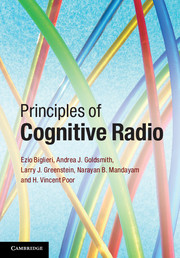1 - The concept of cognitive radio
Published online by Cambridge University Press: 05 December 2012
Summary
Motivation for cognitive radios: spectrum is underutilized
Wireless spectrum is one of the most important resources required for radio communications. Throughout the world, spectrum utilization is regulated so that essential services can be provided and also protected from harmful interference. Traditional spectrum governance across the world has tended toward static long-term exclusivity of spectrum use in large geographic areas, often based on the radio technologies employed at the time of decision making. In particular, until recently spectrum regulatory bodies such as the Federal Communications Commission (FCC) in the US or the European Telecommunications Standards Institute (ETSI) in Europe have always allocated spectrum frequency blocks for specific uses, and assigned licenses for these blocks to specific groups or companies.
While the more or less static spectrum allocation strategy has led to many successful applications like, for example, broadcasting and cellular phones, it has also led to almost all of the prime available spectrum being assigned for various applications (see [63]). It may thus seem that there is little or no spectrum available for emerging wireless products and services.
On the other hand, there have been several studies and reports over the years that show that spectrum is in fact vastly underutilized. A report presenting statistics regarding spectrum utilization showed that even during the high demand period of a political convention such as the one held in 2004 in New York City, only about 13% of the spectrum opportunities were utilized [59].
- Type
- Chapter
- Information
- Principles of Cognitive Radio , pp. 1 - 40Publisher: Cambridge University PressPrint publication year: 2012



